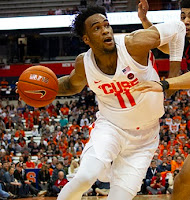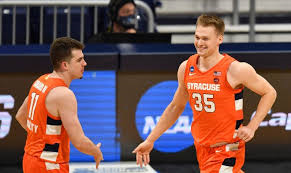Syracuse University has the well publicized all-family affair this year with Coach Jim Boeheim, and his two sons Buddy and Jimmy playing on the squad. They are the 14th set of brothers to play for the Orangemen, and the sixth set to play on the same team.
Chronologically, these are the other sets of brothers.
Max Riehl was a four year player/three year starter for the Orangemen from 1905 to 1908. He was known as being a good ball handler, and handled the critical center position his last two seasons. His younger brother Albert played guard for the Orangemen from 1911 to 1913. Albert played a vital reserve his first two seasons and was a starter his senior year.
David Lee played forward for the Orangemen for two seasons, 1906 and 1907. He was the second leading scorer his senior year, and the top scorer from the floor, averaging over 6 points a game. His younger brother Matt played three seasons from 1908 to 1910. He was a sharp shooting forward, and led the Orangemen in scoring his junior and senior seasons, as well as serving as the team captain his senior year. Matt scored over 328 points in his career, while David scored over 50.
Walt Darby was a starting guard for Syracuse in 1909, and played another season. His brother Sam played one game in 1913.
John Cronauer was one of the stars of the 1918 Helms Foundation National Champion Orangemen. John was second in overall scoring, and the leading scorer from the field averaging 8.8 points per game His older brother Ed played with him that same season primarily in a reserve role. John died suddenly of heart failure at the age of 20 the start of his junior year. Ed, on the other hand, lived to be 100. John scored 141 points in his brief career, while Ed scored 4.
Ev Katz was a vital part of the famed Reindeer Five squad from 1929 to 1931. He was a steady scorer, an extremely fast player, and was credited with being one of the first players in the country to utilize the one handed set shot. His younger brother Milt would play basketball with Everett for two seasons, in a reserve role. Ev would score 470 points in his three seasons, while Milt scored 1 point.
Elmer Maister was an outstanding defensive guard who started for three seasons from 1932 to 1934. His older brother Mike was a star on the freshman football and basketball teams. He was slated to be a starter on the basketball team in 1926, but had academic issues and played only one game. Elmer scored 179 points, while Mike failed to score.
Jim Bruett was a reserve center on the basketball team for one season 1938, scoring 5 points. His younger brother Bill was a reserve guard for three seasons from 1939 to 1941 scoring 4 points.
John Beck was a solid reserve for the Orange for three seasons., playing both the guard and center positions from 1948 to 1950. His older brother Charles was a reserve guard for two seasons, from 1942 to 1943. John scored 150 points while Charles scored 2.
Joe Glacken played for the Orangemen during the World War II era, with two seasons pre-war (1942-1943), and one season post war (1947). Joe led the team in scoring his sophomore season despite primarily being a reserve player. He would be the team captain his senior season, though he was a reserve. His younger brother Ed joined him on the team in 1947, also playing in the majority of the games, but as a reserve. The Glacken brothers also played on the Syracuse baseball team together.
Three Stark brothers played basketball for the Orange. Mike was the oldest, and played four seasons from 1946 to 1950. Mike had excellent shooting skills, and though small, he was a spark to the offense. Pat was a guard for two seasons 1952 and 1953, but he played basketball after the football season end. Pat had All East All-American status in football at quarterback his junior and senior seasons. Lou was the youngest, and was a reserve in 22 games in 1955 and 1956. Mike scored 257 points in his career, Pat 161, and Lou 11.
Bill and Bob Finney played in 1972. Bill was a key reserve his sophomore year, and a starter for most of his junior year. He would be injured and miss the 1971 season, returning in 1972 to join his brother. Bob was a seldom used reserve his sophomore and junior seasons, and would transfer after his junior year. Bill would score 324 points in his career, Bob scored 8.
Mike and Jimmy Lee were by far the best brother combination in Syracuse history. Both scored over 1,000 points in their careers (Mike with 1,351, Jimmy with 1,165). Mike was a three year starting forward, known for his tenacious rebounding and prolific scoring. He was a solid free throw shooter making 78.7% of his attempts, including 34 consecutive. Jimmy a significant contributor all three seasons, he played, and a starter his junior and senior seasons. Jimmy was a terrific free throw shooter making 85.9% of his free throw attempts, and was well known for his perimeter shooting. He made a clutch 18 foot jumper to beat North Carolina in the huge upset in the 1975 NCAA tournament. The two brothers played together in the 1973 season.
Currently the Orange has Shane Feldman on the team as a walk on guard. He played one game as a freshman in 2021. His older brother Ky was a walk on guard for four seasons 2016 through 2019, scoring 10 points.
Of the brothers mentioned above six played together: Jimmy and Mike Lee for one year, Joe and Ed Glacken for one year, Everett and Milt Katz for two years, Bill and Bob Finney for one season, and John and Ed Cronauer for one season. Jimmy and Mike Lee led the Orangemen to a 24-5 record in 1973 and an NCAA berth. The brothers averaged 25.9 points, 4.7 assists, and 7.7 rebounds per game.
If Buddy and Jimmy can have success together like the Lee brothers, this should be a good year for Syracuse.








